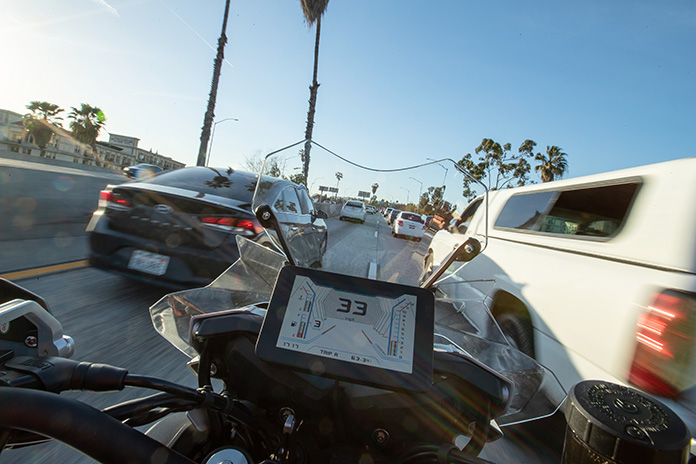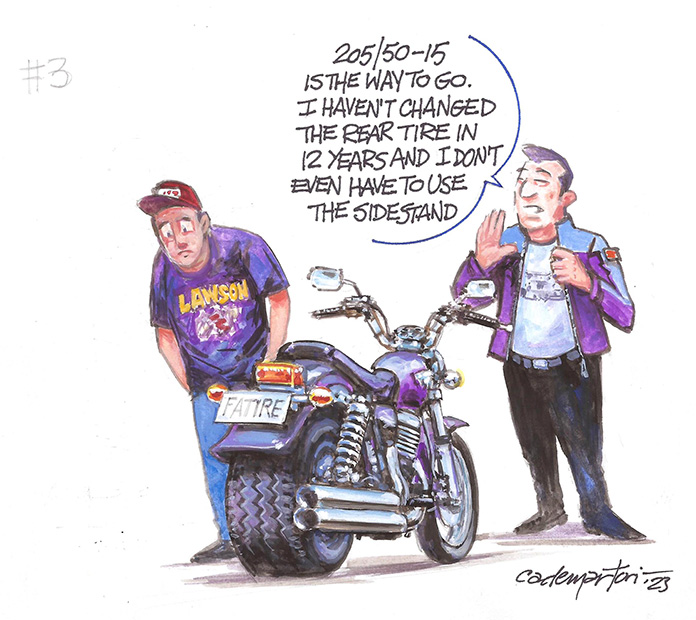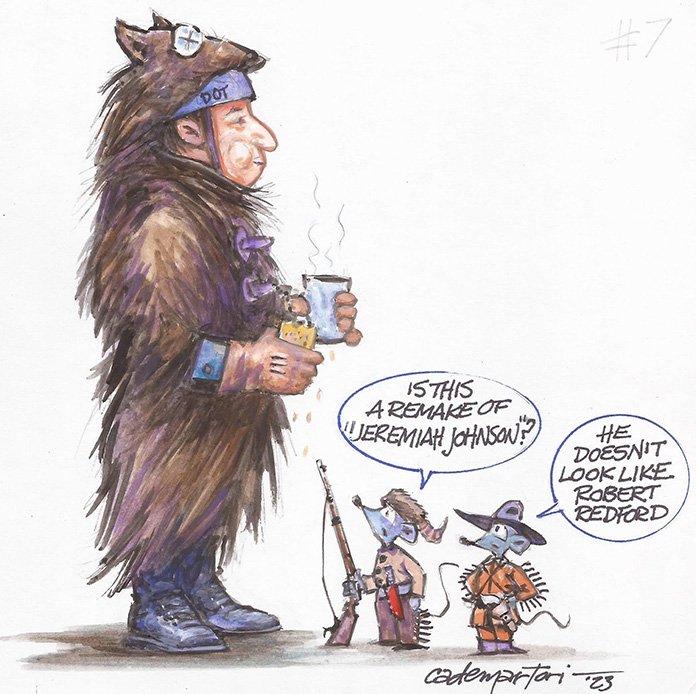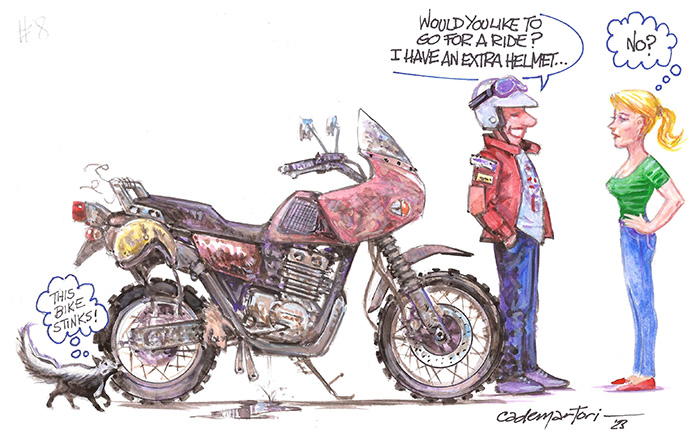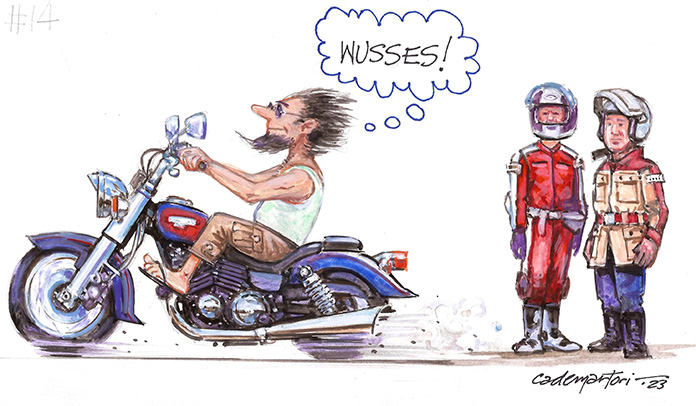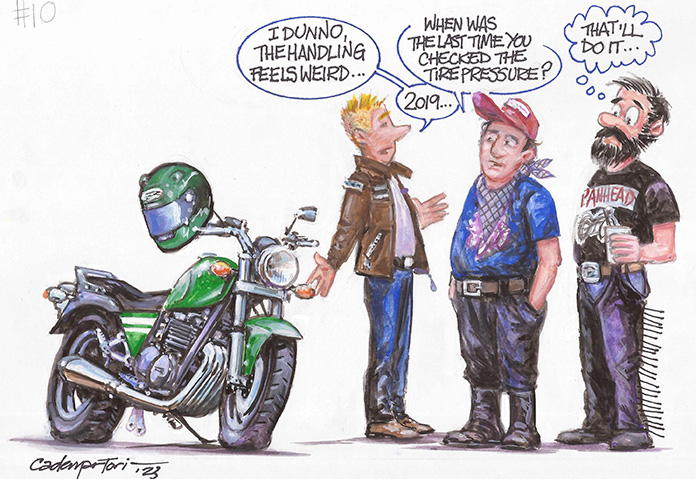As a rider for over 50 years and writer for motorcycle magazines for more than 25 years, I’ve heard motorcyclists spout some bizarre beliefs. Here are some of the most enduring motorcycle myths. Each is bogus.
1. Loud pipes save lives. Loud pipes mean more power.
The first of my motorcycle myths is a twofer. First off, loud pipes don’t save lives, but becoming a better rider can. Some people also assume a louder exhaust (one with little or no baffling) makes more power. While a less restrictive exhaust may add a bit more horsepower at the top of the rev range, they often perform poorly unless corresponding changes are made to the intake side. OEM exhausts are designed to provide horsepower and torque where it matters – in the midrange where you spend most of your time riding.
2. Open-face helmets are just as good as full-face helmets.
Full-face motorcycle helmets provide better protection than open-face helmets because they cover the entire head, including the chin and face. Seeing photos of riders with the bottom half of their face torn off convinced me.
A meta-analysis in Preventive Medicine Reports found that full-face helmets reduce the risk of head injuries by 64% and neck injuries by 36% compared to open-face helmets. A full-face helmet’s faceshield protects the face and provides a clear view, and the fully enclosed design reduces noise by up to 30 decibels. Overall, full-face helmets provide better protection, more comfort, and increased safety.
See all of Rider‘s Helmet reviews here.
3. Using car tires on motorcycles is fine.
Does anyone still buy this myth? Using car tires on motorcycles can be dangerous. The Motorcycle Industry Council warns: “Never mount a passenger car tire on a motorcycle rim; the flat profile of a car tire is incompatible with the dynamics of a vehicle that leans as it corners, and the section of the tire in contact with the rim (the ‘bead’) is incompatible with motorcycle rims.”
Tales from the Dark Side, Eric Trow’s feature in Rider on this topic, includes a quote from motorcycle safety expert and AMA hall-of-famer David Hough: “Motorcycle engineers get up awfully early in the morning to calculate what works best for bikes. An owner who disregards the engineers’ advice should think carefully about his or her talents in being more clever than the engineers. The owner who installs tires not designed for the task must take full responsibility for the results.”
Related: Tales From the Dark Side: Putting Car Tires on Motorcycles
4. The rear brake stops a bike better than the front brake.
Using the front brake to stop a motorcycle is more effective and safer than relying on the rear brake. No exercise was practiced more and drilled into us harder during police motor officer training than proper braking. According to the Motorcycle Safety Foundation, the front brake provides over 70% of a motorcycle’s stopping power. It is more effective because as you brake, a motorcycle’s weight shifts forward, giving the front tire more grip. The front brake also provides better control and stability, especially in emergency situations, whereas the rear tire can lock up and skid, leading to loss of control. Using both brakes together provides the shortest stopping distance.
5. “I had to lay it down.”
This refers to intentionally laying a motorcycle on its side to avoid an impending crash. In other words, crashing to avoid a crash. This is not only pointless, it’s dangerous. Every millisecond of braking before impact reduces speed and the severity of damage. Experienced riders and safety organizations such as the MSF emphasize that riders should maintain control of the motorcycle and try to avoid an accident altogether through proper use of the brakes. Laying the bike down is a sign of panic and lack of proper training and experience. It can result in road rash, broken bones, and even death.
6. Lane splitting is dangerous.
Research has shown lane splitting reduces traffic congestion and improves traffic flow. A study by the University of California Berkeley found that lane splitting reduces traffic delays by up to 40%. Lane splitting can be safer for motorcyclists because it reduces the likelihood of being hit from behind by distracted or inattentive drivers. The study also found no increased risk of crashes for motorcyclists who practice it safely and responsibly. Once only allowed in California, it is now legal in various forms in four states. For more on this topic, check out Eric Trow’s feature, Split Decision: Are Lane Splitting and Lane Filtering Safe?.
7. BMWs are more reliable than other motorcycles.
I own a BMW motorcycle, and I’ve owned, ridden, tested, or rented bikes from nearly every major manufacturer. As you can expect, I have opinions about brand reliability, but don’t take my word for it. A 2015 Consumer Reports survey of 11,000 motorcycle owners provided the following ranking of brands in terms of reliability: 1. Yamaha, 2. Honda, 3. Suzuki, 4. Kawasaki, 5. Harley-Davidson, 6. Triumph, 7. Ducati, and 8. BMW.
See all of Rider‘s BMW coverage here.
8. Leather motorcycle apparel offers the best protection.
In truth, the best protective gear is the gear you use and wear all the time. In some instances, Kevlar (a synthetic material five times stronger than steel and with excellent abrasion resistance) and Cordura (a durable nylon that’s also resistant to abrasion) are considered superior to leather. They also weigh less than leather and can keep you cooler, a significant benefit in hot weather.
See all of Rider‘s Apparel reviews here.
9. Being a passenger on a motorcycle is just like being a rider.
Early in my riding days, I gave little thought to what my passenger was experiencing. Eventually, I wised up, and an article I wrote about riding with passengers became one of my most requested reprints. A passenger’s perspective on a motorcycle is very different from the rider’s. If you have any doubts, hop on the passenger seat and ride for 50 miles with someone else at the controls. Passengers can impact the bike’s handling. Riding with a good passenger is wonderful; riding with those who are scared or unfamiliar with how a motorcycle handles can be a total disaster.
10. Real riders never wash their bikes.
A good friend and fellow motorcycle journalist never washed his bike. He bragged that every bug he ever hit was still there. It was a case of pride over performance. My post-trip habit is to thoroughly wash and detail my motorcycle. In the process, I examine every cable and fastener to ensure it is snug and in its proper place. Going over the bike inch by inch, I often find little things wrong that, if unaddressed, could have caused big problems later. Riders should take the time to clean their own bike and know what to look for. This is the motorcyclist’s equivalent of a pilot flight pre-check. It can save your life.
11. Aftermarket performance accessories improve performance.
My friend Kevin Brown says one of the first things he learned at the Motorcycle Mechanics Institute was to ask the following questions of a rider who complained his bike was not running right: “What did you do to it? Did you add any accessories or make any performance enhancements?” Turns out a high percentage of bikes could be fixed by simply removing the addition. The chances you’ll improve the performance of your bike by adding something is highly unlikely. Usually it runs worse.
See all of Rider‘s Parts & Accessories reviews here.
12. Turn your handlebar in the direction you want to go.
Motorcyclists control the direction of travel by using “countersteering.” This means the rider turns or pushes the handlebar in the opposite direction of the turn. In other words, steer left to turn right, and vice versa. This works because as you turn in the opposite direction, the bike and rider will lean in the direction you wish to go. Many riders are unaware of this but make the correct movement unconsciously.
Related: Stayin’ Safe: Countersteering
13. Car drivers see motorcycles and will stop for you.
Automobile drivers don’t look for motorcycles the way they watch for other cars. They often will look directly at you yet fail to register the presence of a motorcycle. I credit a good part of my surviving so many motorcycle miles without incident to pretending my bike and I are wrapped in an invisibility cloak and no one can see me. Because of this mindset, I expect cars to pull out in front of me and am always prepared with a “Plan B.”
14. Only wusses wear protective gear.
Those who have had accidents often credit their protective gear with saving their lives. My riding friends operate with the motto ATGATT, meaning “All The Gear, All The Time.” Full protective gear includes a good helmet and armored jacket, gloves, pants, and boots. Some riders now use airbag vests or suits. Many seriously injured bikers lament from a hospital bed: “But I was only going three blocks to the store. I didn’t want to get all suited up just for that.”
15. Raingear keeps you dry in the rain.
I’m told some raingear works well. My experience, however, is that rain almost always seeps into small cracks or seams, and before I know it, I’m soaked. I’ve owned at least five pairs of “waterproof” gloves and only one pair worked. Same for boots. If you are riding in the rain, prepare to get wet.
16. Interstate highways are dangerous.
Interstate highways, while certainly not the most fun, are generally considered the safest place to ride a motorcycle due to their consistent speeds and limited access, which minimizes cross traffic. According to the NHTSA, interstates have the lowest fatality rates per mile traveled compared to other road types. Two-lane roads pose a higher risk due to their narrow lanes and lack of barriers between opposing lanes of traffic. City streets and parking lots pose the highest risk of accidents for motorcyclists due to higher levels of congestion, frequent intersections, and obstacles.
17. Riding side by side within a lane like Ponch and Jon on CHiPs is the best way to ride.
Motorcyclists are safest when riding in a staggered formation. It provides greater visibility and more space for emergency maneuvers and stopping. It also makes it easier to signal your fellow riders should the need arise.
Related: Stayin’ Safe: Group Riding Tips
18. Faced with a potential accident, you can avoid injury by jumping off your motorcycle.
Like “laying it down,” this may be tempting if it appears you are about to crash, but it’s a bad idea and will likely result in serious injury or death. Sticking with the motorcycle, attempting to control it, and having faith in its ability to stop, rapidly change direction, and get you out of a tight situation is nearly always the better choice. Motorcycles are far more capable than we give them credit for.
19. Once you set the correct tire pressure on your bike, you can forget it.
Tire pressure has a significant influence on the performance and safety of a motorcycle. Keeping both tires at the correct pressure provides the best ride quality, traction, stability, and control. Incorrect tire pressure negatively impacts wear on the tires and hurts your mileage. All motorcycle tires lose air to some extent, so it is imperative to always check for correct pressure before every ride.
In his book The Power of Myth, Joseph Cambell wrote that mythologies have value because they “support our quest for wisdom and happiness.” Loud pipes may make you feel cool, and backroads may be the most fun, but don’t believe loud pipes will save your life or that backroads are safer. Motorcycle myths are still myths – widely held but false beliefs.
See all of Rider‘s Tips & Tricks articles here.
The post 19 Common Motorcycle Myths appeared first on Rider Magazine.
Source: RiderMagazine.com

